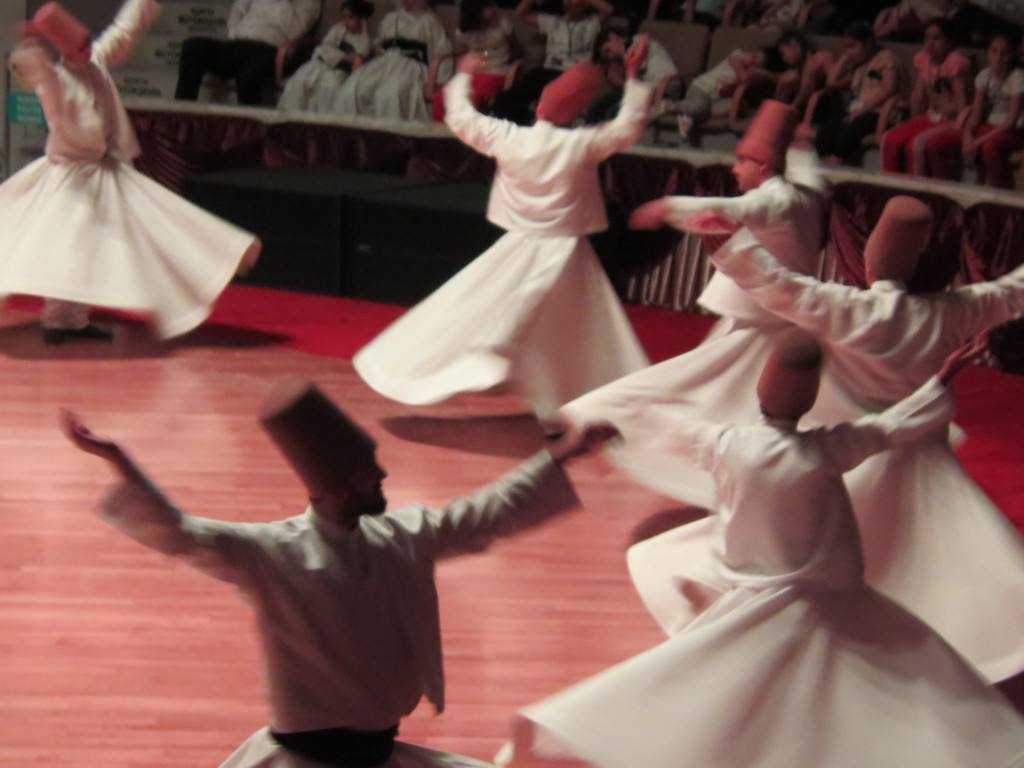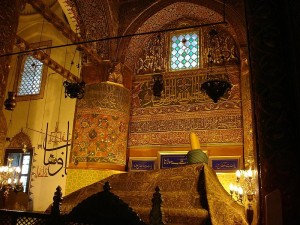
Rumi’s Rest, Rumi’s Renaissance: Drinking the Here and Now in the Heart of Sufism
We came to Konya to be near Rumi.
Near in any sense. Just near. Near is good.
Might our poetry improve? Our philosophy? Our humanity? Our effect on others’ lives?
The scientist in me doubts divinity, but I would be tickled pink to have proximity to Rumi generate positive proof of God.
He’s called Mevlana here: Master.
Jalāl ad-Dīn Rumi inspired the Islamic sect of Sufism. He invented the dervish dance in Konya when he heard “la ilaha ilallah” tapped out by goldsmith’s hammers and twirled with joy (In English that’s, “no god but Allah.”).
In his lifetime he published more than 64,000 couplets and quatrains of poetry in Persian.
He put a thousand fine edges on Islamic thinking (and Jewish thinking and Christian thinking) and then smashed them to bits whenever he got the chance, preferring mysticism over dogma. Know the divine directly.
Rumi’s most heartfelt love, after God, his companion and mystical catalyst—Shams Tabrizi—was killed by Rumi’s followers, jealous that Shams had more influence with Mevlana than they.*
Quite a human, really.
I am amazed at the seeker of purity
who when it’s time to be polished
complains of rough handling.

The rooftop spires of the Mevlana Museum in Konya, Turkey. The unusual turquoise tower is atop Rumi’s crypt. The smaller domes in the foreground are the cells where dervishes lived and contemplated the mystic way.
He died, by the way, in 1273.
And so we make sure we are in Konya on a Saturday. In the heat of the day we visit the Mevlana Museum.
The grounds of the museum have a pretty garden (The Turks love their roses!), a tea stall, and displays about dervish life crammed into monastic cells, but the real draw is Rumi himself.
Rumi’s resting place is in a distinctive mosque that is open to non-believers like me.
To enter we must don disposable shoe covers. Supposedly one-size-fits-all, I tear seven of the dainty elastic over-slippers before I find two that will squeak over my average-for-my-height leather walkers. Alison and all of Trukdom are amused.
Dramatic calligraphy and an intricately carved door guard the entrance.
Just inside, a massive sliver bowl for catching April rain seems more than just placation for dusty Anatolian farmers. Rumi thought of water constantly.
…Give up subtle thinking, the twofold, threefold
multiplication of mistakes.
Listen to the sound of waves within you.
You are dreaming your thirst,
when the water you want
is inside the big vein on your neck.
Most of this mosque is plain enough—white plaster, cracked in places, with some detailing around the windows—probably as Rumi would have wanted it, if the dervish cells and practices are any indication.
Crowds of the Faithful sidestep their way around the hall, hands raised, praying. The sarcophagi start small and grow. The southwest corner is ablaze with tile and calligraphy. That’s where Rumi is. His tomb has the biggest turban on it. His tomb’s outer silk blanketing the richest.
Yet there are chips in the tile and some of the calligraphy seems faded.
Do I hear Rumi laughing?
Where there is ruin, there is hope for a treasure.
In the evening we hike out along Aslani Kisla, past the Hilton, to the Mevlana Culture Center.
This is the house that Rumi built, more than 700 years after his death.
It’s almost a palace, dressed in white marble, still warm from the day’s sun. Lights are beginning to shine on its façade when we arrive. Busses are pulling in. Crowds are beginning to gather.
It’s Saturday, remember?
Once a week, true dervishes—long-time Sufis, not modern dance students acting in an Istanbul dinner theater—perform Sema. People, including us, come from all over the world to get a dose of the real religion.
The cultural center has two spaces dedicated to Sema. They are circular, the performance floor about 20-30 meters in diameter. Each has a terraced seating capacity to about 3,000. One indoors, one outdoors.
We step into the center an hour before the performance is scheduled to start, hoping to attend the pre-service lecture, figuring, “Even it’s in Turkish they might show a video or something from which we can grok the context.”
The main space, sparkling white, is abustle with a half dozen dealers selling works of art and handicrafts. We have maybe thirty seconds to take it in before a beautiful voice announces over loudspeakers: “The English language lecture will begin in five minutes.”
(Islamic countries have lots of loud speakers. They perch atop every minaret of every mosque. Not one sounds as good as this.)
And a man appears at our elbow. “You are here for the English-language lecture?” Absolutely. “Follow me.”
Our lecturer is a professor from McGill University in Montreal. His smile is beatific, his manner obsequious, his English a cultivated clarity: his vocabulary is immense and he has chosen to retain strong accents of his native Trukish.
The “library” in which our lecture takes place feels lavishly furnished with new chairs and deep carpets, but the wall we are facing has wallpaper of library bookshelves instead of real books.
Make no mistake: the five books that matter here are Rumi’s:
The Maṭnawīye Ma’nawī, the Dīwān-e Kabīr, the Fihi Ma Fihi, and the Majāles-e Sab’a, and the Makatib.
Seats in the sema hall are saved for us, we plunge into the life and messages of Rumi, and at the end the foundation that runs the center gifts everyone a copy of the Maṭnawīye Ma’nawī, Rumi’s magnum opus of religious teachings.
We travelers have to think hard before accepting the gift because it’s no pamphlet! Printed on six-by-nine inch paper, there are nearly a thousand pages and it’s more than two inches thick.
Don’t be satisfied with stories, how things have gone with others. Unfold your own myth.
To the hall!
The seats are plush, the lighting has more sophistication than your average stadium concert, and there are lengthy instructions in English and Turkish.
Shhh! Remember, this is a religious ceremony. No applause. Pictures? Okay. Flash? Not okay.
When the instructions are done, a sort of hush falls upon the crowd. I say “sort of” because there are roughly 2,000 Turks in the room and Turks are not known for their reserve.
Musicians file in to a special bandstand (They are dervishes, too, their music as deeply spiritual as the movement.), pelts are laid out on the hardwood floor.
The room twists a turn tighter when the semazens file in and then kneel on their sheepskins, awaiting the ceremony’s official start.
The start is vocal. And I am still picking my jaw off the floor as I write. Lyrically it is exaltation to Mohammed and therefore Allah. Musically? I have spent quite a bit of time listening to micro-tone vocals because Flamenco singing does not confine itself to the Western musical scale, but I have never before heard a human being play their voice like a cello—so fluidly, so powerfully, with such control, and never with a purely held tone—every instant a vibrato, slide, and dip. Musically it was supremacy of precision and beauty: absolute mastery of lungs, throat, and mouth.
After a drum note brings the world into existence, the ney player—the ney is a reed flute—improvises the breath of God. Such musicianship! As full of wonderment and reaching, reaching, reaching as anything John Coltrane ever put wind to.
Shift the lights. Begin the dance.

Semazens redistribute cosmic energy while the crowd looks on. Their tall, smoky grey hats represent their own gravestones.
I cringe at writing the word dance, but I think we must sometimes embrace the limitations of our native language.
When the lights change, the semazens bow and parade and whirl and retire to the edges of the floor and are called forth again and again and again.
As first time viewers we have little sense of time during the four phases of the dance. Do we feel a raising of our consciousness? An amazement at God’s power? The loss of the mind to love? A contemplation of the spiritual journey?
Sema is a multitude: ballet with a limited vocabulary of forms; hypnosis with mindful repetition; modern dance with a surprising degree of individual expression and latitude; intervention with the semazen capturing God’s cosmic energy in the upturned hand and spreading it about with the downturned hand.
The modern theatrical Rumi is bedazzling.
I am all orders of being, the circling galaxy,
the evolutionary intelligence, the lift,and the falling away. What is,
and what isn’t. You who knowJelaluddin, You the one
in all, say whoI am. Say I
am You.
One floats home on a cloud of red light.
Dizzily,
Chris
*In a less dramatic version, Shams is merely run out of town on a rail.
The Rumi quotes in this piece are from the following sources, in order of appearance.
“The seeker of purity…” The Rumi Collection: An Anthology of Translations of Mevlana Jalaluddin Rumi (Shambhala Classics), page 119
Excerpt of “The Water You Want” from A Year With Rumi by Coleman Barks
“Where there is ruin…” is, as far as I can determine, in the public domain. http://quotingquotes.com/39480/
“Don’t be satisfied with stories…” from The Essential Rumi by Jalal al-Din Rumi, Coleman Barks (Translator), and John Moyne (Translator)
Excerpt of “Say I Am You…” from Say I Am You: Poetry Interspersed With Stories of Rumi and Shams by Jalal al-Din Rumi, Coleman Barks (Translator), and John Moyne (Translator)
Tourists are not allowed to take photos of Rumi’s tomb. The one you see here is from Wikimedia Commons:
https://commons.wikimedia.org/wiki/File:Tomb_of_Jalal_ad-Din_Muhammad_Rumi_at_the_Mevlâna_mausoleum.jpg
Original uploader was Aboww at tr.wikipedia

Recent Comments